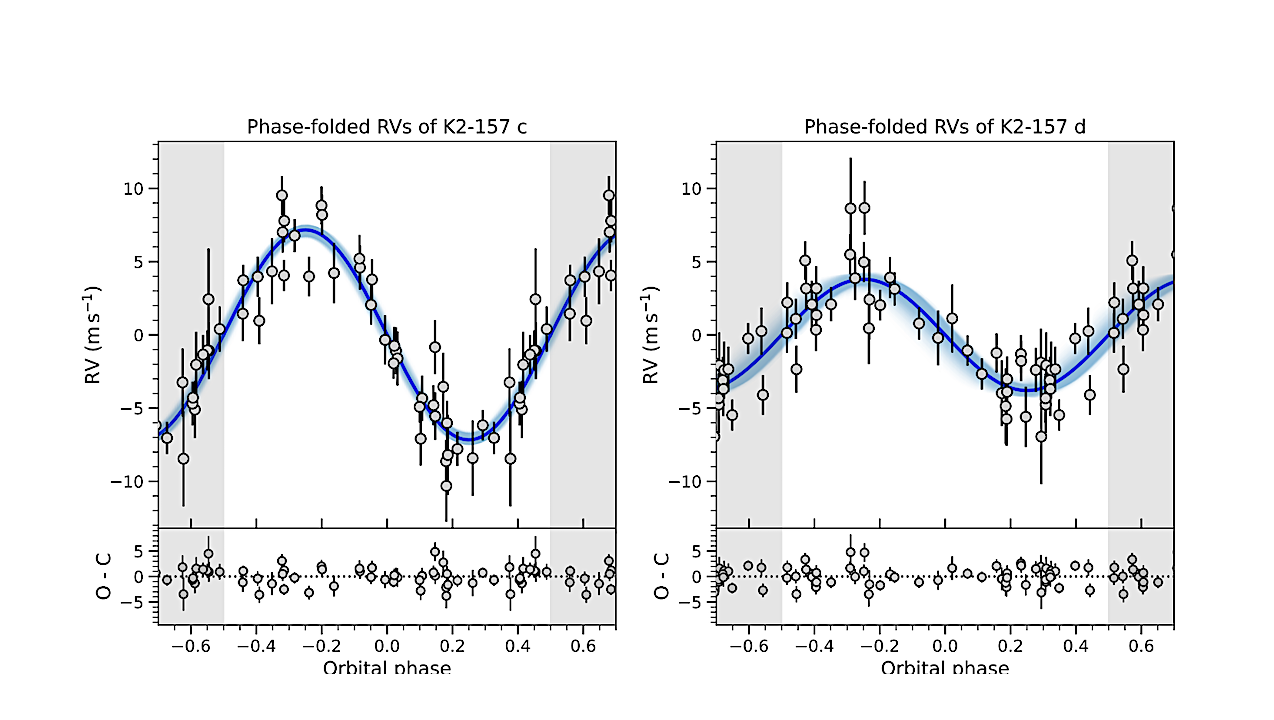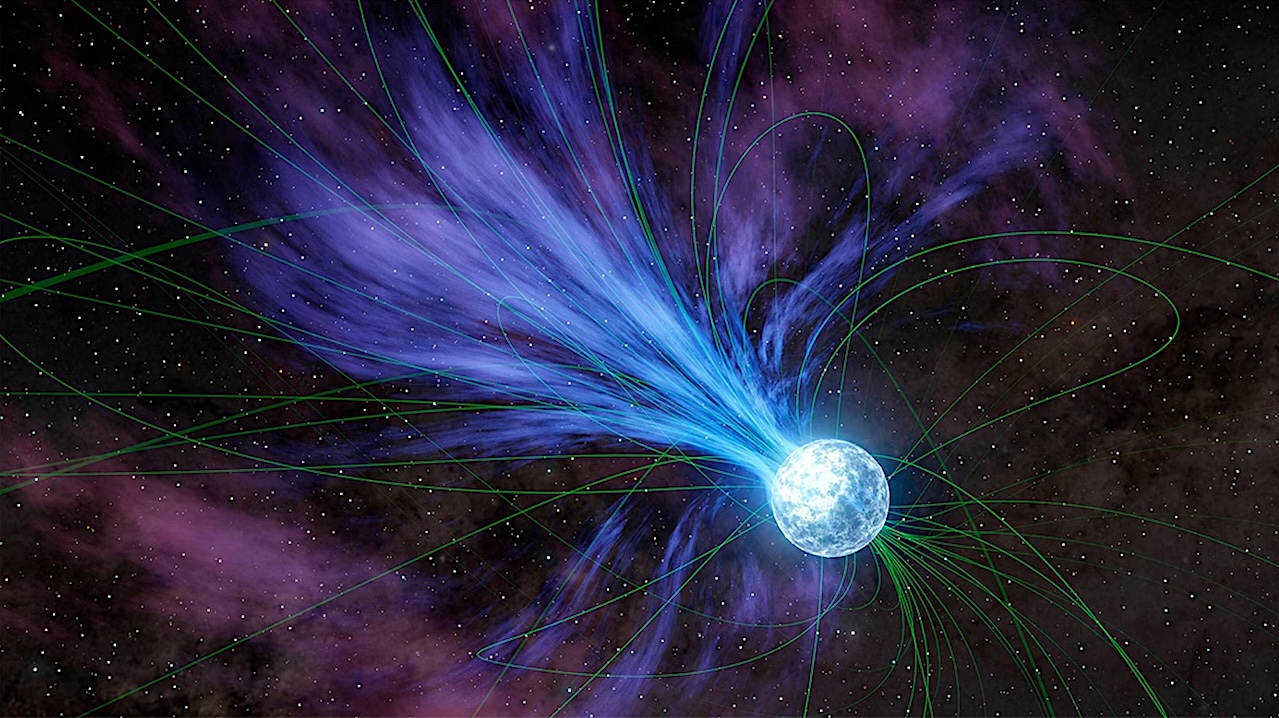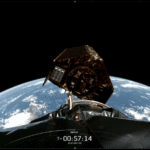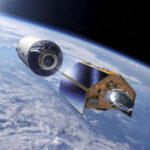Now Reading: Two Neighbours To The Ultra-short-period Earth-sized Planet K2-157 b In The Warm Neptunian Savanna
-
01
Two Neighbours To The Ultra-short-period Earth-sized Planet K2-157 b In The Warm Neptunian Savanna
Two Neighbours To The Ultra-short-period Earth-sized Planet K2-157 b In The Warm Neptunian Savanna


ESPRESSO RVs of K2-157 c (left) and K2-157 d (right) folded to their respective orbital periods inferred in Sect. 4.4. The blue solid lines indicate the median posterior models, and the shades indicate the 1σ confidence intervals. — astro-ph.EP
The formation and evolution of ultra-short-period (USP) planets is poorly understood. However, it is widely thought that these planets migrated inwards through interactions with outer neighbours.
We aimed to confirm and characterize the USP Earth-sized planet K2-157 b (Porb = 8.8 h). To do so, We measured 49 radial velocities (RVs) with the ESPRESSO spectrograph and derived the properties of the system through a RV and transit model.
We detect two additional super-Neptune-mass planets within the warm Neptunian savanna, K2-157 c (Porb,c = 25.942+0.045−0.044 d, Mp,csini = 30.8±1.9 M⊕), and K2-157 d (Porb,d = 66.50+0.71−0.59 d, Mp,dsini = 23.3±2.5 M⊕). The mass of K2-157 b, Mp,b = 1.14+0.39−0.41 M⊕ (< 2.3 M⊕ at 3σ), together with its radius, Rp = 0.935 ± 0.090 R⊕, make the planet compatible with a rocky composition. K2 data discard non-grazing transit configurations for K2-157 c (ic < 88.4∘ at 3σ), and ESPRESSO data constrain the eccentricities of K2-157 c and K2-157 d to ec < 0.2 and ed < 0.5 at 3σ.
At a population level, we find that the trend that the closest USP planets tend to orbit late-type stars does not hold when scaling the orbital separation to the Roche limit, which suggests that the orbital distribution of the closest planets across spectral types is determined by tidal disruption.
The orbital architecture of K2-157 is unusual, with only one similar case reported to date: 55 Cnc. The USP planets of these systems, being accompanied by massive, long-period, relatively spaced, and possibly misaligned neighbours, could have migrated inwards through eccentricity-based mechanisms triggered by secular interactions.
A. Castro-González, F. Bouchy, A. C. M. Correia, A. Sozzetti, J. Lillo-Box, P. Figueira, B. Lavie, C. Lovis, M. J. Hobson, S. G. Sousa, V. Adibekyan, M. R. Standing, N. C. Hara, D. Barrado, A. M. Silva, V. Bourrier, J. Korth, N. C. Santos, M. Damasso, M. R. Zapatero Osorio, J. Rodrigues, Y. Alibert, S. Cristiani, P. Di Marcantonio, J. I. González Hernández, G. Lo Curto, C. J. A. P. Martins, N. J. Nunes, E. Palle, F. Pepe, A. Suárez Mascareño, H. M. Tabernero
Comments: Accepted for publication in Astronomy & Astrophysics. Abstract shortened. 31 pages, 28 figures
Subjects: Earth and Planetary Astrophysics (astro-ph.EP)
Cite as: arXiv:2504.20999 [astro-ph.EP] (or arXiv:2504.20999v1 [astro-ph.EP] for this version)
https://doi.org/10.48550/arXiv.2504.20999
Focus to learn more
Submission history
From: Amadeo Castro-González
[v1] Tue, 29 Apr 2025 17:59:57 UTC (13,824 KB)
https://arxiv.org/abs/2504.20999
Astrobiology,
Stay Informed With the Latest & Most Important News
Previous Post
Next Post
-
 012024 in Review: Highlights from NASA in Silicon Valley
012024 in Review: Highlights from NASA in Silicon Valley -
 02Panasonic Leica Summilux DG 15mm f/1.7 ASPH review
02Panasonic Leica Summilux DG 15mm f/1.7 ASPH review -
 03How New NASA, India Earth Satellite NISAR Will See Earth
03How New NASA, India Earth Satellite NISAR Will See Earth -
 04And Thus Begins A New Year For Life On Earth
04And Thus Begins A New Year For Life On Earth -
 05Astronomy Activation Ambassadors: A New Era
05Astronomy Activation Ambassadors: A New Era -
06SpaceX launch surge helps set new global launch record in 2024
-
 07Space Force plans new ‘Futures Command’ amid pressure to speed up modernization
07Space Force plans new ‘Futures Command’ amid pressure to speed up modernization




















